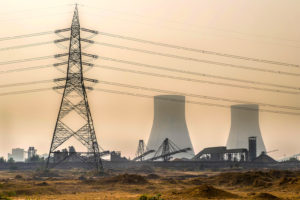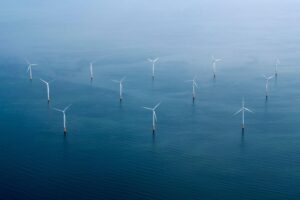Welcome to Carbon Brief’s DeBriefed.
An essential guide to the week’s key developments relating to climate change.
This week
China’s ‘two sessions’
‘CONCRETE MEASURES’: China’s premier Li Qiang said the country will work “diligently” and take a “series of concrete measures” to achieve the country’s “dual-carbon” goals of peaking CO2 emissions before 2030 and achieving carbon neutrality by 2060, state newspaper China Daily reported. Li made the comments as he delivered the “report on the work of the government”, a major policy document that outlines key priorities for 2025, at the nation’s all-important annual “two sessions” meeting, it said.
RENEWABLES PACKAGE: China also announced plans to develop a package of major projects to tackle climate change at the meeting, Reuters reported. A new report from the country’s National Development and Reform Commission outlined plans to develop new offshore wind farms and accelerate the construction of “new energy bases”, it added. However, coal will remain a “key fuel”, with plans to increase production and supply, the article noted.
NEW NEGOTIATOR: Li Gao was promoted to vice minister at China’s Ministry of Ecology and Environment, replacing Zhao Yingmin, who served as the head of China’s delegation to COP29, according to Bloomberg. Li is a “climate negotiator” with “two decades of experience in global climate change talks” and an “advocate of the country’s carbon-credit programme”, the article noted.
Trump continues cuts
CUTTING FORESTS: Trump signed an executive order to expand logging across 280m acres of US national forests and other public lands, the Guardian reported. Conservation groups warned that this could have a “disastrous impact on climate change, endangered species and local economies dependent on ecotourism”, added Inside Climate News.
‘NATIONAL DISASTER’: BBC News reported that around 880 workers at the US National Oceanic and Atmospheric Administration (NOAA) were fired last week. Reuters said that Jane Lubchenco, the former NOAA administrator under Barack Obama, called the layoffs a “national disaster and a colossal waste of money”, adding: “Destroying NOAA’s ability to provide life-saving information, keep our ocean healthy and strengthen the economy makes no sense – no sense at all.”
‘PIVOTAL CENTERS’: The Trump administration told NOAA that “two pivotal centres for weather forecasting will soon have their leases cancelled”, sources told Axios this week. Elsewhere, Reuters reported that the US is pulling out of the Just Energy Transition Partnership, where wealthy countries help support developing countries to move away from coal, according to several participating countries.
Around the world
- INDIAN AVALANCHE: An avalanche in the Himalayan state of Uttarakhand that killed eight people was triggered by a 600% surge in precipitation within 24 hours, fuelling “climate concerns”, reported the Times of India.
- EU EMISSIONS: The European Commission announced that carmakers will have three more years to meet emissions rules, but the 2035 ban on the sale of petrol and diesel cars remains in place, according to the Financial Times. Reuters added the EU is also still committed to its interim target for zero-emission car sales for 2030.
- JAPANESE WILDFIRE: Japan’s biggest wildfire in 30 years has burned around 2,100 hectares and killed one person so far, the South China Morning Post reported.
- CLIMATE MULTILATERALISM: Brazil will use the COP30 climate summit in November to “press for multilateralism and respect for science”, said president-designate Andre Aranha Correa do Lago, according to Reuters.
- NORTH SEA: The UK has confirmed it will not issue new North Sea oil and gas licences and announced a 2030 end date for the “windfall tax”, first introduced when fossil-fuel company profits skyrocketed in 2022, in new plans released ahead of a consultation, the Press Association reported.
36
The number of fossil-fuel companies responsible for half of global CO2 emissions, the Guardian reported.
Latest climate research
- An AI-driven assessment of COP side events from 2003-23 published in Nature Climate Change examined how fossil-fuel lobbyists have been gaining access to UN climate summits to “uncover power dynamics at the highest levels of climate governance”.
- In a high-emissions future, melting Antarctic ice could lead to Earth’s strongest ocean current slowing down by 20% by 2050, according to a new study in Environmental Research Letters.
- Women and girls continue to bear a disproportionate impacts from heatwaves in South Sudan, according to a new World Weather Attribution analysis.
(For more, see Carbon Brief’s in-depth daily summaries of the top climate news stories on Monday, Tuesday, Wednesday, Thursday and Friday.)
Captured
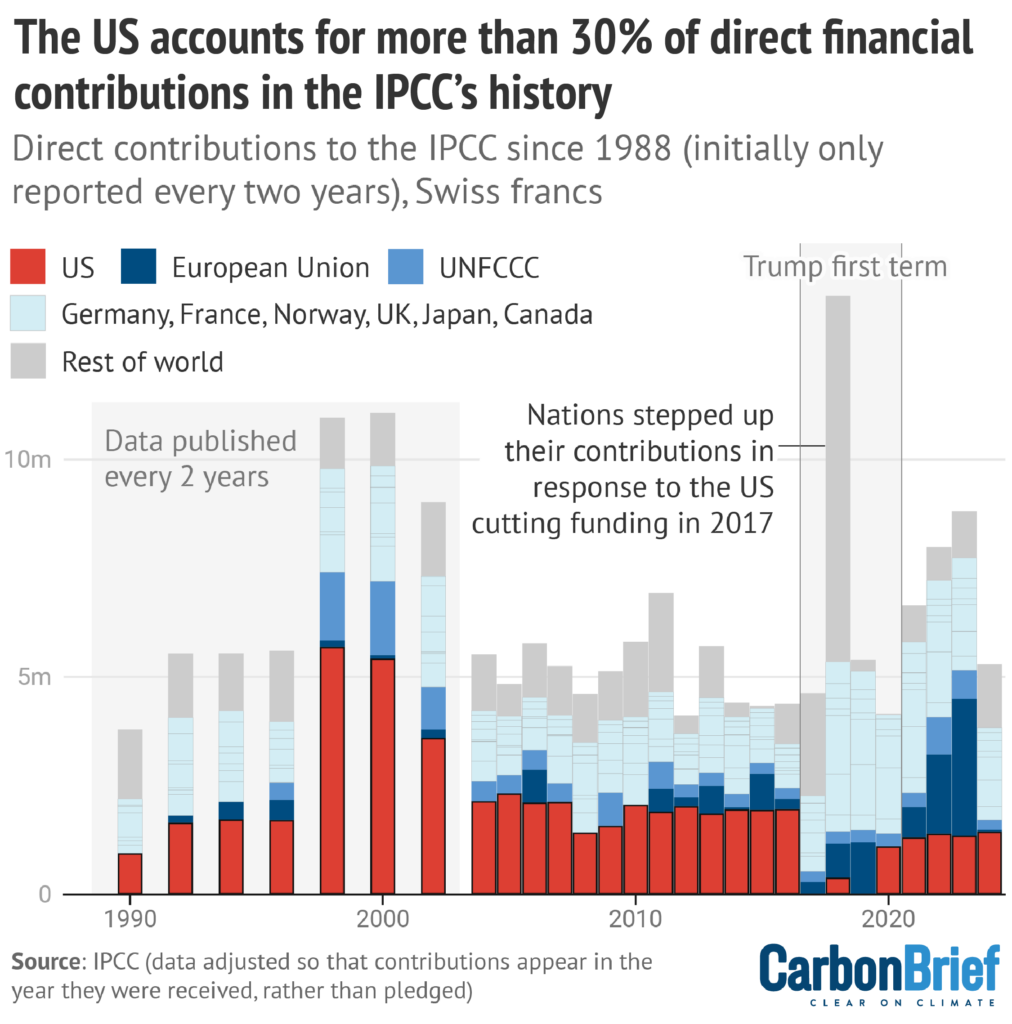
At the Intergovernmental Panel on Climate Change’s (IPCC) meeting in Hangzhou, China, governments failed for a third time to agree to a timeline for the next round of UN climate science reports, according to Climate Home News. The absence of US federal scientists “cast a shadow” over the IPCC meeting, reported the Financial Times. The chart above, from Carbon Brief’s in-depth coverage of the meeting, highlights that the US has provided around 30% of the voluntary contributions to the IPCC’s financial budgets since it was established in 1988.
Spotlight
The ‘Super Grid’ campaign of the 1950s
As the UK looks to expand its grid, Carbon Brief takes a look at what can be learned from the Super Grid expansion 70 years ago.
Electricity demand in the UK is expected to at least double by 2050, requiring an expansion of the grid to keep pace. National Grid has launched the “Great Grid Upgrade“, with at least 17 major infrastructure projects being built as part of this.
However, there has been repeated pushback, with critics condemning plans to “carpet” the countryside with pylons, “devastating” locals and “shattering” rural dreams.
Speaking earlier this year, energy and climate change secretary Ed Miliband said there would need to be a communication campaign to convey the benefits of the expansion, pointing to one during the last big expansion in the 1950s and 60s – known as the “Super Grid”.
Super Grid
The UK’s first electricity transmission grid began operation in 1933 – this excludes Northern Ireland, which is part of Ireland’s power grid. National Grid was created in 1935 and the regional grids were connected into the world’s first integrated national grid in 1938.
By 1950, the grid was at capacity, with demand rising ninefold in just 15 years.
Out of this the idea for a “Super Grid” was born. Made up of 1,150 miles of power lines held by 136-feet-high steel pylons, the grid cost £52m, roughly £1.4bn in today’s prices, over 10 years.
It was designed not just to increase capacity, but also to strengthen the north-to-south interconnections of the existing grid, especially as generation capacity shifted to large coal-fired power stations to the north of London.
After it was announced, opposition around the UK was voiced by local authorities, preservationist groups, voluntary societies and residents, citing concerns about the visual impact of the new pylons on the countryside, as well as concerns around industrialisation and the economy.
Speaking to Carbon Brief, Prof Katrina Navickas at the University of Hertfordshire said that the Super Grid expansions were undertaken during a time when there was a post-war “desire for modernisation, efficiency and growth”, adding:
“These aims were often in tension with popular demands for amenity and countryside preservation, as the national parks were set up from 1949 and a popular idea of preservation of the rural landscape arose out of the right to roam movement.”
Attempts were made to minimise the impact of the pylons on the landscape. For example, the electricity boards argued that the large scale of the infrastructure would fit the landscape better than a “cluster” of smaller grid, noted Navickas.
Debate continued into the 1960s, with ministers questioning the impact of the Super Grid “upon the beauty of the countryside”, calling on army specialists to look at the potential of camouflage and arguing against the pylons being “painted in antinationalisation Tory colours”.
Communication challenges
To try to counter the opposition to the Super Grid and wider grid expansion, the Central Electricity Generating Board (CEGB) launched an information campaign, using articles and adverts to try to convey the benefits of an expanded electricity network.

For example, one advert (above left) highlighted surging electricity demand and the need to ensure supply for future generations.
Others sought to highlight that the CEGB appreciated the need to protect the countryside and expand.
As an advert in Country Life (above right) highlighted, there is a “double duty” that falls on the shoulders of those tasked with managing the grid expansion. This is to “maintain an efficient, economical electricity supply, but also to preserve the amenities of the country”.
Some of the challenges around the attachment to the “amenity value of local landscapes” still exist today, Navickas added:
“But the ecological and environmental considerations are also much more to the fore than they had been in the 1950s and 1960s. Local community consultation has to be at the heart of any planning schemes too, whereas the earlier schemes were implemented in a much more top-down way that assumed that local opposition was based on lack of understanding of national benefits.”
Watch, read, listen
CLIMATE LENS: A new podcast titled Lights, Climate, Action discussed film and TV through a climate lens, with hosts talking about the film Don’t Look Up in their first episode.
ACTIVISM AND TRUMP: Yale360 interviewed activist and author Bill McKibben about “rethinking the role of protest, the global push on clean energy and why he sees reason for hope” in the “age of Trump 2.0”.
WOMEN’S DAY: To mark International Women’s Day, Costa Rican diplomat and former UN climate chief Christiana Figueres is joined by top climate scientist Dr Katharine Hayhoe on her Outrage and Optimism podcast to discuss why ignoring women endangers the climate.
Coming up
- 11 March: Greenland’s general election
- 16-25 March: Climate and Clean Air Conference, Brasilia, Brazil
- 17 March: G20 Second International Financial Architecture Working Group Meeting, Pretoria, South Africa
- 18-19 March: OECD x IEA Global Forum on the Environment and Climate Change, Paris, France
- 18-19 March: Berlin Energy Transition Dialogue, Berlin, Germany
Pick of the jobs
- Union of Concerned Scientists, senior climate scientist | Salary: $134,805. Location: Washington DC/remote
- Intergovernmental Panel on Climate Change, head of communication in the IPCC working group I technical support unit | Salary: Unknown. Location: Paris, France
- Community Energy England, chief operating officer | Salary: £46,000-£52,470. Location: Remote/Sheffield
- Irish Department of the Environment, Climate and Communications, head of circular economy and resource efficiency | Salary: Unknown. Location: Ireland
DeBriefed is edited by Daisy Dunne. Please send any tips or feedback to debriefed@carbonbrief.org.
This is an online version of Carbon Brief’s weekly DeBriefed email newsletter. Subscribe for free here.
The post DeBriefed 7 March 2025: China’s pivotal ‘two sessions’; IPCC indecision; Lessons from UK’s 1950s ‘Super Grid’ appeared first on Carbon Brief.
Greenhouse Gases
DeBriefed 10 October 2025: Renewables power past coal; Legacy of UK’s Climate Change Act; Fukushima’s solar future
Welcome to Carbon Brief’s DeBriefed.
An essential guide to the week’s key developments relating to climate change.
This week
Renewables overtake coal
‘HISTORIC FIRST’: Renewables have overtaken coal to become the world’s leading source of electricity for the first six months of this year in a “historic first”, BBC News said. The analysis, from the thinktank Ember, found the world generated “almost a third” more solar power in the first half of the year, compared with the same period in 2024, while wind power grew by “just over 7%,” reported the Guardian.
HEAVY LIFTING: According to the report, China and India were “largely responsible for the surge in renewables”, while the US and Europe “relied more heavily on fossil fuels,” the Guardian wrote. China built more renewables than every other country combined in the first half of this year, the newspaper added.
CONTINENTAL SHIFTS: A second report from the International Energy Agency (IEA) predicted a “surge” in global wind and solar capacity by 2030, but shaved 5% off its previous forecast, the Financial Times said. The IEA revealed that India is set to become the second-largest growth market for renewables after China, “with capacity expected to increase 2.5 times by 2030”, Down to Earth reported. The IEA also upped its forecast for renewables in the Middle East and north Africa by 23%, “helped by Saudi Arabia rolling out wind turbines and solar panels”, but halved the outlook for the US, the FT noted.
Around the world
- EV BOOM: Sales of electric and hybrid cars made up “more than half” of all new car registrations in the UK last month, a new record, according to data from the Society of Motor Manufacturers, reported BBC News.
- BANKING COLLAPSE: A global banking alliance launched by the UN to get banks to slash the carbon footprint of their loans and investments and help drive the transition to a net-zero economy by 2050 has collapsed after four years, Agence France-Press reported.
- CUTS, CUTS, CUTS: The Trump administration plans to cut nearly $24bn in funding for more than 600 climate projects across the US, according to documents reviewed by the Wall Street Journal.
- PEOPLE POWER: A farmer, a prison guard and a teacher were among those from the Dutch-Caribbean island Bonaire who appeared at the Hague on Tuesday to “accuse the Netherlands of not doing enough to protect them from the effects of climate change”, Politico reported.
400,000
The number of annual service days logged by the US National Guard responding to hurricanes, wildfires and other natural disasters over the past decade, according to a Pentagon report to Congress, Inside Climate News reported.
Latest climate research
- Politicians in the UK “overwhelmingly overestimate the time period humanity has left to bend the temperature curve”, according to a survey of 100 MPs | Nature Communications Earth and Environment
- Fire-driven degradation of the Amazon last year released nearly 800m tonnes of CO2 equivalent, surpassing emissions from deforestation and marking the “worst Amazon forest disturbance in over two decades” | Biogeosciences
- Some 43% of the 200 most damaging wildfires recorded over 1980-2023 occurred in the last decade | Science
(For more, see Carbon Brief’s in-depth daily summaries of the top climate news stories on Monday, Tuesday, Wednesday, Thursday and Friday.)
Captured

The UK’s Climate Change Act, landmark legislation that guides the nation’s response to climate change, is increasingly coming under attack from anti-net-zero right-leaning politicians. In a factcheck published this week, Carbon Brief explained how the UK’s Climate Change Act was among the first comprehensive national climate laws in the world and the first to include legally binding emissions targets. In total, 69 countries have now passed “framework” climate laws similar to the UK’s Climate Change Act, with laws in New Zealand, Canada and Nigeria among those explicitly based on the UK model. This is up from just four when the act was legislated in 2008. Of these, 14 are explicitly titled the “Climate Change Act”.
Spotlight
Fukushima’s solar future
This week, Carbon Brief examines how Fukushima helped to recover from nuclear disaster by building solar farms on contaminated farmland.
On 11 March 2011, an earthquake off the pacific coast of Japan caused 15m-tall waves to crash into the eastern region of Tōhoku, killing 19,500 people and injuring a further 6,000.
In the aftermath, flooding at the Fukushima Daichi nuclear power plant caused cooling systems to fail, leaching radioactive contaminants into the soil and leading to a major nuclear incident.
Some 1,200km2 around the site was restricted and up to 100,000 people were evacuated – in some cases forever.
In the years following, Japan entered a fraught debate about nuclear energy.
In 2010, nuclear power provided 25% of Japan’s electricity, but, in the years following the disaster, its 54 nuclear reactors were taken offline.
Successive governments have fought over reintroducing nuclear power. Today, some 14 reactors are back online, 27 have been permanently closed and another 19 remain suspended. (Japan’s newly-elected prime minister Sanae Takaichi has promised to make nuclear central to her energy strategy.)
Against this backdrop, Fukushima – a prefecture home to 1.8 million people – has emerged as a surprise leader in the renewables race.
In 2014, the Fukushima Renewable Energy Institute (FREA) opened with the twin goals of promoting research and development into renewable energy, while “making a contribution to industrial clusters and reconstruction”.
That same year, the prefecture declared a target of 100% renewable power by 2040.
Contaminated land
“A lot of these communities, I know, were looking for ways to revitalise their economy,” said Dr Jennifer Sklarew, assistant professor of energy and sustainability at George Mason University and author of “Building Resilient Energy Systems: Lessons from Japan”.
Once evacuation orders were lifted, however, residents in many parts of Fukushima were faced with a dilemma, explained Skarlew:
“Since that area was largely agricultural, and the agriculture was facing challenges due to stigma, and also due to the soil being removed [as part of the decontamination efforts], they had to find something else.”
One solution came in the form of rent, paid to farmers by companies, to use their land as solar farms.
Michiyo Miyamoto, energy finance specialist at the Institute for Energy Economics and Financial Analysis, told Carbon Brief:
“The [Fukushima] prefecture mapped suitable sites early and conducted systematic consultations with residents and agricultural groups before projects were proposed. This upfront process reduced land-use conflicts, shortened permitting timelines and gave developers clarity.”
As a result, large-scale solar capacity in Fukushima increased to more than 1,300 megawatts (MW) from 2012 to 2023, according to Miyamoto. Moreover, installed renewable capacity now exceeds local demand, meaning the region can run entirely on clean power when conditions are favourable, Miyamoto said.
Today, aerial pictures of Fukushima reveal how solar panels have proliferated on farmland that was contaminated in the nuclear disaster.

Charging on
Last year, 60% of Fukushima’s electricity was met by renewables, up from 22% in 2011. (The country as a whole still lags behind at 27%.)
And that is set to grow after Japan’s largest onshore windfarm started operations earlier this year in Abukuma, Fukushima, with a capacity of 147MW.
The growth of solar and wind means that Fukushima is already “ahead of schedule” for its 2040 target of 100% renewable power, said Miyamoto:
“The result is a credible pathway from recovery to leadership, with policy, infrastructure and targets working in concert.”
Watch, read, listen
OVERSHOOT: The Strategic Climate Risks Initiative, in partnership with Planet B Productions, has released a four-part podcast series exploring what will happen if global warming exceeds 1.5C.
DRONE WARFARE: On Substack, veteran climate campaigner and author Bill McKibben considered the resilience of solar power amid modern warfare.
CLIMATE AND EMPIRE: For Black history month, the Energy Revolution podcast looked at how “race and the legacies of empire continue to impact the energy transition”.
Coming up
- 12 October: presidential elections, Cameroon
- 13-14 October: Pre-COP, Brasilia, Brazil
- 13-18 October: World Bank Group/IMF annual meetings, Washington DC
- 14-17 October: 2nd extraordinary session of the Marine Environment Protection Committee at the International Maritime Organisation, London
- 15-16 October: Circle of Finance Ministers report
Pick of the jobs
- Buckinghamshire Council, principal climate change officer | Salary: £49,354-£51,759. Location: Aylesbury, Buckinghamshire
- Sustainable NI, sustainable business lead | Salary: £60,000. Location: Belfast, Northern Ireland
- Dialogue Earth, South Asia managing editor | Salary: £1,875 per month. Location: South Asia
DeBriefed is edited by Daisy Dunne. Please send any tips or feedback to debriefed@carbonbrief.org.
This is an online version of Carbon Brief’s weekly DeBriefed email newsletter. Subscribe for free here.
The post DeBriefed 10 October 2025: Renewables power past coal; Legacy of UK’s Climate Change Act; Fukushima’s solar future appeared first on Carbon Brief.
Greenhouse Gases
Guest post: How Caribbean states are shifting climate legislation
The Caribbean region is among the most vulnerable to climate change, despite historically contributing less than half of one percent of global greenhouse gas emissions.
Rising sea levels, extreme heat and more frequent and intense storms – such as the 2024 Hurricane Beryl, which made landfall in Grenada – pose urgent and growing threats to the small island states, coastal nations and overseas territories that comprise the Caribbean region.
With global progress to address climate change still too slow, Caribbean countries are taking matters into their own hands by enacting more robust legislation to help protect against climate risks.
In a new study published in the Carbon and Climate Law Review, we identified 78 climate laws and legally binding decrees across 16 Caribbean states, as well as two constitutional references to climate change and a growing recognition of the right to a healthy environment.
Our analysis suggests that, together, these developments are not only enhancing resilience, but also positioning Caribbean states as influential actors in the global climate arena.
Caribbean climate laws on the rise
Climate governance in the Caribbean has expanded significantly in recent years. In the past decade, countries such as Cuba and the Dominican Republic have embedded climate obligations and programmatic guidelines into their national constitutions.
At the same time, legislative recognition of the human right to a healthy environment is gaining momentum across the region. Six Caribbean nations now affirm the right in their constitutions, while 15 have recognised it through international instruments, such as the UN Council, UN Assembly and the Escazu Agreement, as shown in the figure below.
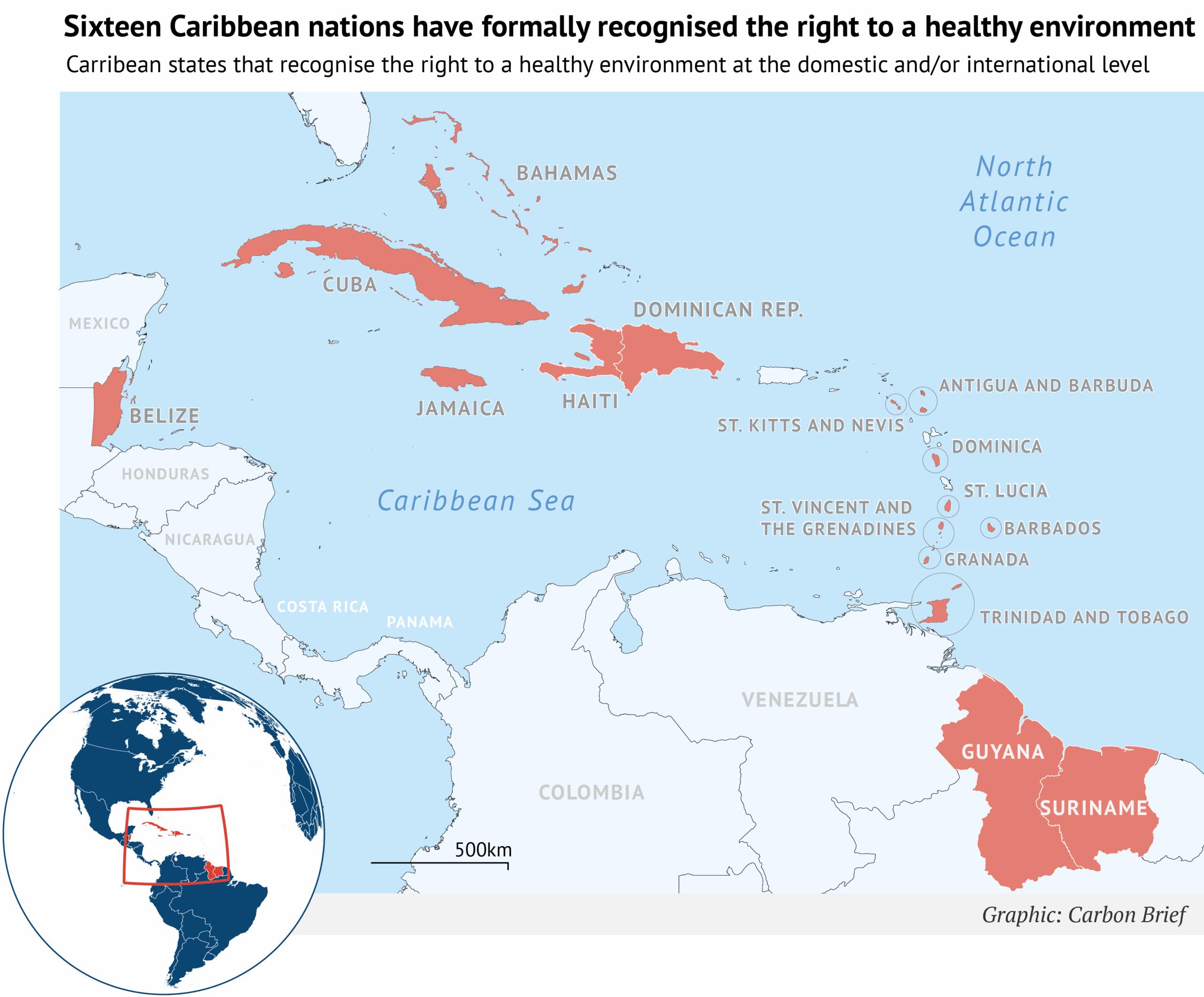
More recently, there has been a notable rise in targeted, sector-specific climate frameworks that go beyond broader environmental statutes.
Saint Lucia stands out as the only country with a climate framework law, or a comprehensive national law that outlines long-term climate strategies across multiple domains. Meanwhile, several other Caribbean governments have adopted climate-specific laws that focus on individual sectors, such as energy, migration and disaster management.
According to our analysis, more than a quarter of climate-relevant legislation in the region – comprising 21 laws and legally binding decrees – now has an explicit focus on climate change, as illustrated in the chart below.
Our research suggests that this represents an ongoing shift in legislative focus, reflecting changes in how climate legislation is being structured in one of the world’s most climate-vulnerable regions.
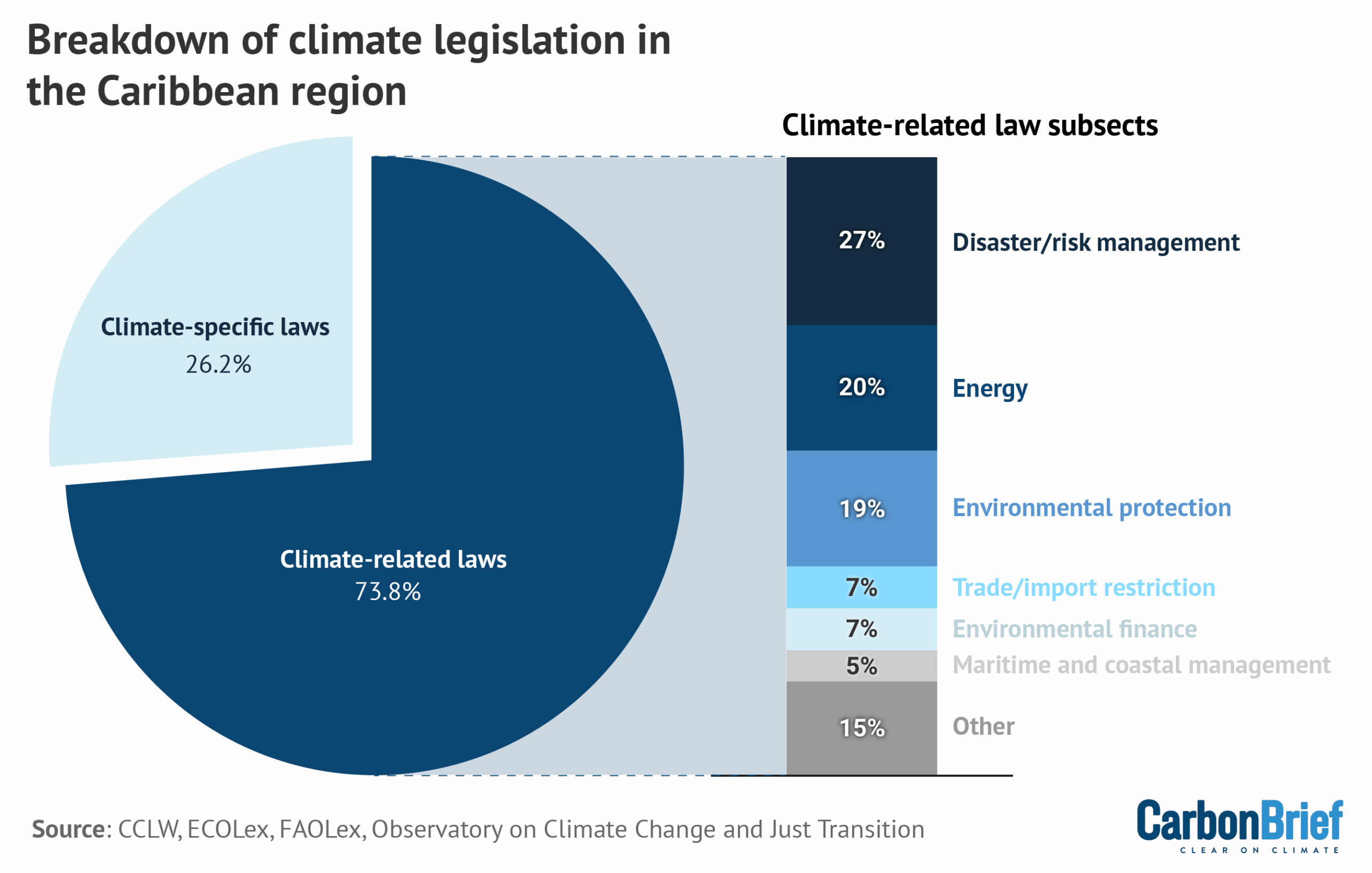
Caribbean nations are also advancing legal reforms to structure and institutionalise climate finance and market mechanisms directly into domestic law, aligned with Article 6.2 of the Paris Agreement.
For example, the Bahamas has introduced provisions for carbon credit trading, while Antigua and Barbuda, Barbados and Grenada have established national climate financing mechanisms to support mitigation and adaptation efforts.
Some states, including Belize and Saint Kitts and Nevis, have incorporated regional bodies such as the Caribbean Community Climate Change Centre – the climate arm of the intergovernmental Caribbean community organisation CARICOM – into national frameworks. This indicates an increasing alignment between regional cooperation and domestic law.
In addition to the influx of regulations specifically addressing climate change, Caribbean nations are also legislating broader environmental issues, which, in turn, could provide increased resilience from climate impacts and risks, as shown in the graph above.
Key trends in these types of climate-related laws include the expansion of disaster risk management governance, which addresses national preparedness for climate-induced weather events or related catastrophes. Likewise, energy law is an increasingly prominent focus, with countries including Antigua and Barbuda and Saint Vincent and the Grenadines integrating renewable energy and energy efficiency goals into national climate governance.
More broadly, many Caribbean nations have adopted wide-ranging and comprehensive environmental laws, many of which were developed in alignment with existing climate commitments. In combination, these legal developments reflect a dynamic and evolving climate governance landscape across the region.
Proactive vs reactive approaches
Despite general alignment with these broader regional trends, our research reveals distinct developmental pathways shaping domestic climate regulation.
In the eastern Caribbean, for example, we saw both proactive, long-term planning strategies and reactive, post-disaster reforms.
Saint Lucia’s multifaceted approach to climate resilience evolved steadily over the course of more than a decade. During this time, the country developed numerous adaptation plans, strengthened cross-sectoral coordination and engaged in institutional climate reforms in areas such as energy, tourism, finance and development.
More recently, the passage of Saint Lucia’s Climate Change Act in 2024 marked a milestone in climate governance, by giving legal force to the country’s obligations under the UNFCCC, the Kyoto Protocol and the Paris Agreement – making Saint Lucia one of the few small island states to incorporate global climate commitments into domestic law.
Our research indicates that this strategy has not only positioned the country as a more climate-resilient nation, but also solidified its access to international climate financing.
In contrast, Dominica’s efforts evolved more rapidly in the aftermath of Hurricane Maria in 2017, which destroyed over 200% of the country’s GDP. The storm’s impacts were felt across the country and hit particularly hard for the Kalinago people – the Caribbean’s last Indigenous community – highlighting the role of socioeconomic disparities in shaping climate vulnerability and resilience.
In response, the government passed the Climate Resilience Act, creating the temporary Climate Resilience Execution Agency for Dominica (CREAD).
Beyond establishing an exclusively climate-focused institution, the act aimed to embed resilience into governance by mandating the participation of vulnerable communities – including Indigenous peoples, women, older people and people with disabilities – in shaping and monitoring climate resilience projects.

As noted in a recent statement by the UN special rapporteur on Climate Change, Dr Elisa Morgera, these frameworks underscore the government’s ambition to become the world’s first “climate-resilient nation.”
Although challenges persist, Dominica’s efforts demonstrate how post-disaster urgency can drive institutional change, including the integration of rights and resilience into climate governance.
Uneven progress and structural gaps
Despite significant progress, our research shows that several key opportunities for climate governance across the Caribbean continue to exist, which could enable improvements in both resilience and long-term ambition.
The region’s legal landscape remains somewhat heterogeneous. While Saint Lucia has enacted a comprehensive climate framework law, the rest of the region lacks similar blanket legislation. This includes some states that entirely lack climate-specific laws, instead relying on related laws and frameworks to regulate and respond to climate-related risks.
Other nations have yet to adopt explicit disaster-risk management frameworks, leaving Caribbean populations vulnerable before, during and after climate emergencies. Most have yet to enshrine the right to a healthy environment at the national level.
Our research suggests that outdated legal frameworks are further limiting progress in addressing current climate risks. Because many of the longer-standing environmental laws in the region were adopted well before climate policy became a mainstream concern, some fail to address the nature, frequency and intensity of modern climate challenges, such as sea-level rise, tropical storms, wildfires, floods, droughts and other impacts.
More broadly, many Caribbean climate laws include limited integration of gender equity, Indigenous rights and social justice. As Caribbean nations such as Grenada and the Dominican Republic begin to link climate resilience with these issues, the region has an opportunity to lead by example.
Ultimately, capacity and resource constraints persist as significant barriers to implementation and adaptation.
The Caribbean region faces debt that exacerbates ongoing development challenges, a burden made heavier by the repeated economic shocks of climate-related disasters. Along with regional debt-for-resilience schemes, increased funding from high-emitting countries to support adaptation measures in climate-vulnerable nations – as endorsed under the Paris Agreement – is likely to be critical to ensuring the region’s climate laws can be executed effectively.
Global implications of Caribbean climate law
Our research suggests that Caribbean countries are outpacing other regions in terms of the scope and ambition of their climate laws. This legislation has the potential to serve as a model for climate-vulnerable nations worldwide.
Continuing efforts in the region show that legal frameworks in the field can not only drive resilience, embed rights and strengthen claims to international finance, but also highlight how regional cooperation and diplomacy can enhance global influence.
These findings demonstrate that innovation in climate law need not wait for action from major emitters, but can instead be led by those on the front lines of climate change.
The post Guest post: How Caribbean states are shifting climate legislation appeared first on Carbon Brief.
Guest post: How Caribbean states are shifting climate legislation
Greenhouse Gases
IEA: Renewables have cut fossil-fuel imports for more than 100 countries
More than 100 countries have cut their dependence on fossil-fuel imports and saved hundreds of billions of dollars by continuing to invest in renewables, according to the International Energy Agency (IEA).
It says nations such as the UK, Germany and Chile have reduced their need for imported coal and gas by around a third since 2010, mainly by building wind and solar power.
Denmark has cut its reliance on fossil-fuel imports by nearly half over the same period.
Renewable expansion allowed these nations to collectively avoid importing 700m tonnes of coal and 400bn cubic metres of gas in 2023, equivalent to around 10% of global consumption.
In doing so, the fuel-importing countries saved more than $1.3tn between 2010 and 2023 that would otherwise have been spent on fossil fuels from overseas.
Reduced reliance
The IEA’s Renewables 2025 report quantifies the benefits of renewable-energy deployment for electricity systems in fossil fuel-importing nations.
It compares recent trends in renewable expansion to an alternative “low renewable-energy source” scenario, in which this growth did not take place.
In this counterfactual, fuel-importing countries stopped building wind, solar and other non-hydropower renewable-energy projects after 2010.
In reality, the world added around 2,500 gigawatts (GW) of such projects between 2010 and 2023, according to the IEA, more than the combined electricity generating capacity of the EU and US in 2023, from all sources. Roughly 80% of this new renewable capacity was built in nations that rely on coal and gas imports to generate electricity.
The chart below shows how 31 of these countries have substantially cut their dependence on imported fossil fuels over the 13-year period, as a result of expanding their wind, solar and other renewable energy supplies. All of these countries are net importers of coal and gas.

In total, the IEA identified 107 countries that had reduced their dependence on fossil fuel imports for electricity generation, to some extent due to the deployment of renewables other than hydropower.
Of these, 38 had cut their reliance on electricity from imported coal and gas by more than 10 percentage points and eight had seen that share drop by more than 30 percentage points.
Security and resilience
The IEA stresses that renewables “inherently strengthen energy supply security”, because they generate electricity domestically, while also “improving…economic resilience” in fossil-fuel importer countries.
This is particularly true for countries with low or dwindling domestic energy resources.
The agency cites the energy crisis exacerbated by Russia’s invasion of Ukraine, which exposed EU importers to spiralling fossil-fuel prices.
Bulgaria, Romania and Finland – which have historically depended on Russian gas for electricity generation – have all brought their import reliance close to zero in recent years by building renewables.
In the UK, where there has been mounting opposition to renewables from right-wing political parties, the IEA says reliance on electricity generated with imported fossil fuels has dropped from 45% to under 25% in a decade, thanks primarily to the growth of wind and solar power.
Without these technologies, the UK would now be needing to import fossil fuels to supply nearly 60% of its electricity, the IEA says.
Other major economies, notably China and the EU, would also have had to rely on a growing share of coal and gas from overseas, if they had not expanded renewables.
As well as increasing the need for fossil-fuel imports from other countries, switching renewables for fossil fuels would require significantly higher energy usage “due to [fossil fuels’] lower conversion efficiencies”, the IEA notes. Each gigawatt-hour (GWh) of renewable power produced has avoided the need for 2-3GWh of fossil fuels, it explains.
Finally, the IEA points out that spending on renewables rather than imported fossil fuels keeps more investment in domestic economies and supports local jobs.
The post IEA: Renewables have cut fossil-fuel imports for more than 100 countries appeared first on Carbon Brief.
IEA: Renewables have cut fossil-fuel imports for more than 100 countries
-
Climate Change2 years ago
Spanish-language misinformation on renewable energy spreads online, report shows
-
Climate Change2 months ago
Guest post: Why China is still building new coal – and when it might stop
-
Climate Change Videos2 years ago
The toxic gas flares fuelling Nigeria’s climate change – BBC News
-

 Greenhouse Gases1 year ago
Greenhouse Gases1 year ago嘉宾来稿:满足中国增长的用电需求 光伏加储能“比新建煤电更实惠”
-
Greenhouse Gases2 months ago
Guest post: Why China is still building new coal – and when it might stop
-

 Climate Change1 year ago
Climate Change1 year ago嘉宾来稿:满足中国增长的用电需求 光伏加储能“比新建煤电更实惠”
-

 Carbon Footprint2 years ago
Carbon Footprint2 years agoUS SEC’s Climate Disclosure Rules Spur Renewed Interest in Carbon Credits
-
Renewable Energy3 months ago
US Grid Strain, Possible Allete Sale







